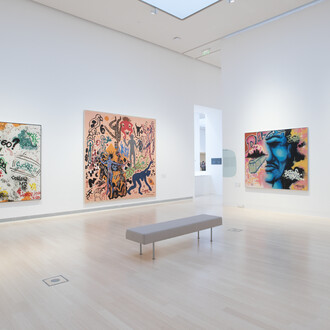András Nagy’s sensitive perspective is probably best known from his work as a cinematographer, for example in the feature films Bibliotheque Pascal, White Palms, or Eternal Winter. Besides creating moving pictures and constructed spectacles, he has also established a more liberated, peculiar photographic universe. Melting snowmen, a bush on the verge of a field, parking cars in the concrete jungle of housing projects, a playful kitten chasing its shadow, crossing the street. Everyday scenes, locations, objects, which become highlighted by the gesture of taking the photograph. The meticulous compositions and the sometimes seemingly insignificant situations invite the spectators to reevaluate the relationships and interconnections, and take part in a peculiar dialogue.
The questions primarily target the subjects of the images: of whom, where, under what circumstances could they have been taken? The gaze searches for the familiar points of association until the time spent with the images raises our awareness to how the initial concepts must be replaced by a deeper, internal way of perception, the understanding of the symbols. The cars serve as allegorical portraits, life situations, methods of utilization that delineate the personality, behavior, and perspective of their respective owners. Beyond the presence of light, the shadows also point to what is not included in the photograph, the source of the shadow itself. The bushes located on the side of a street or the verge of a field could be symbolically interpreted reaching even as far as the Biblical story of the burning bush, the origin of establishing a kind of moral standard. The human portraits, the contemplating, distant gazes, the steps, the anticipation, the kiss, the dance, the activities extrapolated from the flow of time and placed in a peculiar framework display the elevated contents hidden in the simplest of situations.
András Nagy is the flâneur of Benjamin and Baudelaire, a character wandering on the streets with his observant attitude, turning our attention to everyday situations, locations, objects, and events that we could encounter any day of our lives. The photographs taken on film, with a strictly analog method, do not only call for a disciplined work from the author but also invite a more immersed perception. The exhibition titled Chrono – alluding to the concept of time – includes metaphoric images of the conditions dominating our environment, reflecting upon the prominent and vanishing phenomena, which segment our lives one way or another, either substantially or insubstantially, discernibly or indiscernibly, significantly or insignificantly. (Judit Gellér, curator)
András Nagy (H.S.C.) Member of the Hungarian Society of Cinematographers, Béla Balázs Prize-winner cinematographer. He was born in Budapest in 1972. He studied at the University of Theater and Film, and graduated as a cinematographer in 1996. As a cinematographer, he photographs blockbusters and successful movies screened at festivals, assisting the work of Péter Bergendy, Szabolcs Hajdu, Kornél Mundruczó, Attila Szász and other directors. His outstanding work as a cinematographer has been awarded on numerous occasions by juries of Hungarian (Magyar Filmszemle, Magyar Filmhét, Kamera Hungária) as well as international festivals (Newport Beach Film Festival, Festival du Cinéma de Paris, Tiburon International Film Festival) In 2019, he received the László Kovács and Vilmos Zsigmond Hungarian Cinematographer Award. He was selected as Best Cinematographer at the Goldeneye Cinematographer Festival in 2006, 2010, 2014, and 2019 as well. His photographs had been displayed in the Inda Gallery, Budapest, as well as at the group exhibition titled Microsolutions, where he exhibited together with the artist András Ravasz. The first solo exhibition of András Nagy titled Chrono showcases a selection of his photographs from the past 2–3 years in the Project Room of the Capa Center.
















